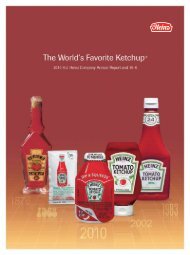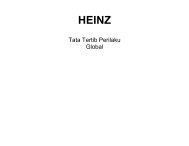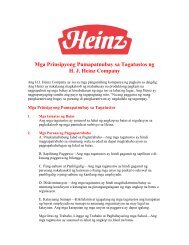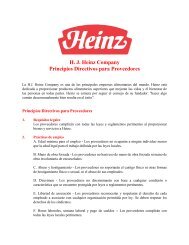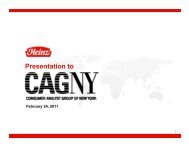ANYTIMEkANYPLACEkANYWHERE - Heinz
ANYTIMEkANYPLACEkANYWHERE - Heinz
ANYTIMEkANYPLACEkANYWHERE - Heinz
You also want an ePaper? Increase the reach of your titles
YUMPU automatically turns print PDFs into web optimized ePapers that Google loves.
The cash flows related to the above financial instruments are classified in the Statements<br />
of Cash Flows in a manner consistent with those of the transactions being hedged.<br />
Recently Issued Accounting Standards: In June 1998, the Financial Accounting Standards<br />
Board (the ‘‘FASB’’) issued Statement of Financial Accounting Standards (‘‘SFAS’’) No. 133,<br />
‘‘Accounting for Derivative Instruments and Hedging Activities.’’ This statement establishes<br />
accounting and reporting standards for derivative instruments. The statement requires<br />
that an entity recognize all derivatives as either assets or liabilities in the statement of financial<br />
position and measure those instruments at fair value. In June 1999, the FASB issued SFAS<br />
No. 137, ‘‘Accounting for Derivative Instruments and Hedging Activities – Deferral of the<br />
Effective Date of FAS Statement 133,’’ which postponed the adoption date of SFAS No. 133.<br />
As such, the company is not required to adopt the statement until Fiscal 2002. In June 2000,<br />
the FASB issued SFAS No. 138, ‘‘Accounting for Certain Derivative Instruments and Certain<br />
Hedging Activities – an Amendment of FASB Statement No. 133.’’ This statement amends the<br />
accounting and reporting standards of SFAS No. 133 for certain derivative instruments and<br />
certain hedging activities. The company is currently evaluating the effect that implementation<br />
of the new standard will have on its results of operations and financial position.<br />
In May 2000, the FASB Emerging Issues Task Force (the ‘‘EITF’’) issued new guidelines<br />
entitled ‘‘Accounting for Certain Sales Incentives’’ which address the recognition, measurement<br />
and income statement classification for certain sales incentives (e.g., coupons). These<br />
guidelines will be effective for the company beginning in the second quarter of Fiscal 2001.<br />
The implementation of these guidelines will require the company to make reclassifications<br />
between selling, general and administrative expenses (‘‘SG&A’’) and sales.<br />
In December 1999, the Securities and Exchange Commission (the ‘‘SEC’’) issued Staff<br />
Accounting Bulletin (‘‘SAB’’) No. 101, ‘‘Revenue Recognition in Financial Statements.’’<br />
SAB No. 101 provides guidance on the recognition, presentation and disclosure of revenue<br />
in financial statements filed with the SEC. SAB No. 101 outlines the basic criteria that must be<br />
met to recognize revenue and provides guidance for disclosure related to revenue recognition<br />
policies. Management believes that the impact of SAB No. 101, which will be effective in the<br />
fourth quarter of Fiscal 2001, will not have a material effect on its financial position or results<br />
of operations.<br />
2. ACQUISITIONS All of the following acquisitions have been accounted for as purchases and, accordingly, the<br />
respective purchase prices have been allocated to the respective assets and liabilities based<br />
upon their estimated fair values as of the acquisition date. Operating results of businesses<br />
acquired have been included in the Consolidated Statements of Income from the respective<br />
acquisition dates forward. Pro forma results of the company, assuming all of the following<br />
acquisitions had been made at the beginning of each period presented, would not be<br />
materially different from the results reported.<br />
Fiscal 2000: The company acquired businesses for a total of $404.9 million, including<br />
obligations to sellers of $10.4 million. The preliminary allocations of the purchase price resulted<br />
in goodwill of $153.4 million and trademarks and other intangible assets of $134.8 million,<br />
which are being amortized on a straight-line basis over periods not exceeding 40 years. Final<br />
allocation of the purchase price is not expected to differ significantly from the preliminary<br />
allocations and is expected to be completed in Fiscal 2001.<br />
On December 7, 1999, the company completed the acquisition of United Biscuit’s European<br />
Frozen and Chilled Division, one of the leading frozen food businesses in the U.K. and<br />
Ireland, which produces frozen desserts and vegetarian/meat-free products, frozen pizzas,<br />
frozen value-added potato products and fresh sandwiches. Also during Fiscal 2000, the<br />
(53)





